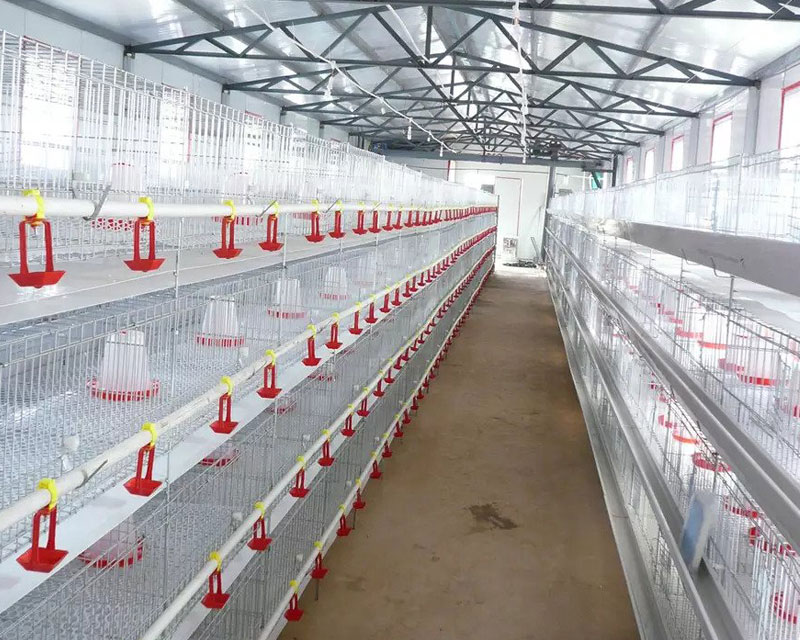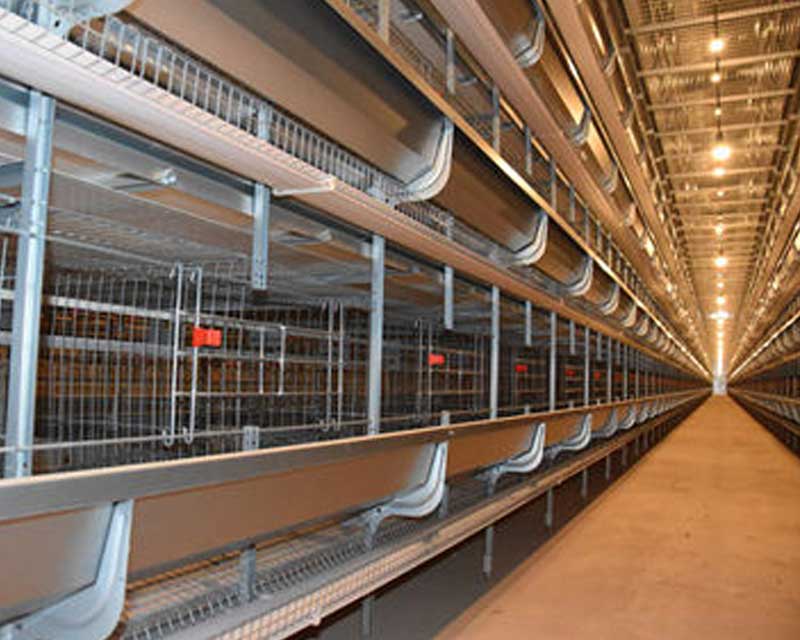Creating Comfortable and Functional Commercial Rabbit Cage Designs
Introduction
Commercial rabbit cage design plays a crucial role in providing rabbits with a comfortable and healthy living environment. Whether you are a seasoned breeder or someone considering venturing into commercial rabbit breeding, understanding the essentials of cage design is vital for the well-being and productivity of your rabbits. This article aims to shed light on the key factors to consider when designing commercial rabbit cages, ensuring optimal comfort, and promoting the welfare of these furry creatures.

By providing adequate space, selecting appropriate materials, incorporating essential features, and prioritizing maintenance, breeders can create a nurturing environment that supports the physical and psychological needs of rabbits. Whether the goal is meat production, pet breeding, or any other purpose, a well-designed commercial rabbit cage fosters the overall health, growth, and contentment of the animals. So, let us delve into the world of commercial rabbit cage design and discover how to create the ideal habitat for these beloved creatures.
Understanding the Requirements of Commercial Rabbit Cage Design:
Several key variables must be taken into account in order to develop a commercial rabbit cage design that satisfies the demands of the rabbits and enhances their well-being. These elements include providing enough room, choosing appropriate materials, and making sure there is adequate ventilation. Breeders can establish an environment that supports the bunnies' natural behaviors and health by being aware of these requirements.
Size and Space
Rabbits need enough room to roam around, exercise, and sleep soundly. The dimensions of the cage should be appropriate for the breed and size of the rabbits. Offering ample space allows rabbits to exhibit their natural behaviors, such as hopping, stretching, and grooming. It also helps prevent stress-related issues and promotes healthier muscle development.
Material Selection
The choice of materials for commercial rabbit cages is essential for durability, safety, and ease of maintenance. Wire mesh and metal bars are commonly used materials. The wire mesh should have a small enough spacing to prevent rabbits from escaping or getting injured. Solid and smooth surfaces are crucial to prevent foot injuries, especially for breeds prone to sore hocks. It is essential to strike a balance between durability and the comfort of the rabbits.
Ventilation
Proper ventilation is crucial in commercial rabbit cages to maintain a fresh and healthy environment. Good airflow helps reduce ammonia buildup from urine and prevents the growth of harmful bacteria. Ventilation can be achieved through openings or vents that allow fresh air to circulate while ensuring adequate protection against drafts and extreme temperatures.

Lighting
Although often overlooked, lighting is an important consideration in commercial rabbit cage design. Natural or artificial lighting should mimic the natural day-night cycle to support the rabbits' circadian rhythm. Sufficient lighting not only allows rabbits to see clearly but also affects their overall well-being and breeding performance.

Security and Safety
Commercial rabbit cages should be designed with security and safety in mind. The materials used should be sturdy and resistant to chewing or damage. All openings, doors, and latches should be secure to prevent escapes or accidental injuries. Special attention should be given to corners and edges to minimize the risk of injury to the rabbits.
By understanding these requirements and incorporating them into the design, breeders can create a commercial rabbit cage that provides a comfortable and secure living space for the rabbits. Next, we will explore the essential features that should be included in a well-designed commercial rabbit cage.
Essential Features of Commercial Rabbit Cages
A well-designed commercial rabbit cage should incorporate essential features that cater to the specific needs of the rabbits. These features promote the rabbits' comfort, safety, and overall well-being, while also facilitating efficient management for breeders. Let's explore the key features that should be included in commercial rabbit cage designs:
Multiple Compartments
Commercial rabbit cages often consist of multiple compartments or sections to house several rabbits. Each compartment provides individual housing, which is crucial for minimizing aggression and stress among rabbits. Separating rabbits into their own spaces allows them to have their territory and reduces the likelihood of injuries or conflicts. Each section should have a separate door for easy access and cleaning.
Flooring Options
There are different flooring options to consider for commercial rabbit cages. Wire mesh flooring allows for efficient waste management, as droppings can easily pass through, reducing the risk of soiling the rabbits. However, to provide comfort and prevent foot injuries, it is important to incorporate resting boards or mats for rabbits to sit or lie on. Solid flooring, such as plastic or metal pans, may be used in certain areas, such as nesting or resting areas, for added comfort.
Feeders and Waterers
Commercial rabbit cages should have convenient and easily accessible feeders and waterers. These can be built-in or attachable to the cage walls. Automatic or gravity-fed systems can be employed to ensure a continuous supply of fresh food and water for the rabbits. Adequate access to feed and water is essential for proper nutrition and hydration, promoting overall health and productivity.

Nesting Areas for Breeding
For breeding purposes, commercial rabbit cages should include separate nesting areas or compartments. These areas provide privacy and comfort for does (female rabbits) to give birth and care for their young kits. Nesting boxes or enclosures with suitable nesting materials are necessary to create a warm and secure environment for the newborn kits.

Ventilation and Airflow
Proper ventilation is crucial in commercial rabbit cages to maintain optimal air quality and reduce ammonia buildup. The cage design should incorporate adequate ventilation openings or vents to ensure proper airflow without exposing the rabbits to drafts. This helps to minimize respiratory issues and ensures a fresh and healthy environment within the cages.
Easy Cleaning and Maintenance
Commercial rabbit cages should be designed with easy cleaning and maintenance in mind. Removable trays or floors facilitate efficient waste removal and cleaning. Doors and access points should allow breeders to reach all areas of the cage easily for thorough cleaning, inspection, and maintenance.
Durability and Safety
Commercial rabbit cages need to be constructed with sturdy and durable materials to withstand the rabbits' activity and ensure their safety. The materials used should be resistant to corrosion, rust, and damage caused by chewing. Additionally, all corners, edges, and fasteners should be smooth and free from sharp points or protrusions to minimize the risk of injury to the rabbits.
By incorporating these essential features into commercial rabbit cage designs, breeders can create a comfortable, secure, and efficient housing system that promotes the rabbits' well-being and allows for effective management of the breeding operation. In the next section, we will explore the importance of regular maintenance and cleaning considerations for commercial rabbit cages.
Maintenance and Cleaning Considerations
Proper maintenance and regular cleaning are crucial aspects of commercial rabbit cage management. By implementing effective cleaning practices, breeders can ensure a hygienic and healthy environment for the rabbits, minimizing the risk of diseases and promoting their overall well-being. Here are some important considerations for maintenance and cleaning in commercial rabbit cages:
Regular Cleaning Schedule
Establishing a consistent cleaning schedule is essential to maintain cleanliness and prevent the accumulation of waste and odors in the cages. Daily tasks may include removing soiled bedding or droppings, refreshing food and water, and checking for any signs of illness or injury. Additionally, periodic deep cleaning should be conducted to sanitize the cages thoroughly.

Waste Management
Efficient waste management is crucial for maintaining a clean and healthy environment in commercial rabbit cages. Wire mesh flooring allows droppings to pass through, simplifying waste removal. Regularly emptying and cleaning removable trays or pans beneath the cages is necessary to prevent ammonia buildup and keep the rabbits' living space hygienic.
Sanitation and Disinfection
Regular sanitization and disinfection of the cages are essential for preventing the spread of diseases and ensuring optimal hygiene. Before introducing new rabbits into a cage, thoroughly clean and disinfect the entire cage, including all surfaces, feeding equipment, and waterers. Use appropriate disinfectants recommended for rabbit housing and follow the instructions for safe and effective use.
Safe Cleaning Products
When cleaning commercial rabbit cages, it is crucial to use safe and non-toxic cleaning products. Harsh chemicals or cleaning agents that may leave residue or fumes harmful to rabbits should be avoided. Consider using mild detergents or natural cleaning solutions that are safe for both the rabbits and the environment.
Inspection and Maintenance
Regularly inspecting the cages for any signs of damage, wear, or hazards is essential. Check the structural integrity of the cage, ensuring that there are no loose wires, broken bars, or sharp edges that could potentially harm the rabbits. Promptly address any maintenance or repair needs to maintain a safe and secure housing environment.
Record-Keeping
Maintaining detailed records of cleaning schedules, health observations, and any changes in the rabbits' behavior or condition is beneficial. This information can help track the rabbits' well-being, identify potential health issues, and ensure that proper cleaning protocols are followed consistently.
By adhering to a regular maintenance and cleaning routine, breeders can create a clean and healthy environment for their rabbits, promoting their overall health, well-being, and productivity. Additionally, maintaining detailed records and conducting regular inspections help in early detection of any potential issues, allowing for timely intervention and necessary adjustments to the cage design or management practices.
Proper maintenance and cleaning practices are essential components of commercial rabbit cage management. Regular cleaning, waste management, sanitation, and diligent inspection contribute to a hygienic and comfortable environment for the rabbits. By prioritizing these considerations, breeders can ensure the well-being and optimal health of their rabbits, fostering a successful commercial breeding operation.
Conclusion
Designing and maintaining commercial rabbit cages that prioritize the comfort, safety, and well-being of the rabbits is crucial for the success of any breeding operation. By understanding the requirements of commercial rabbit cage design, breeders can create a nurturing environment that supports the natural behaviors and health of the rabbits.
Providing adequate space, selecting suitable materials, ensuring proper ventilation, and incorporating essential features such as multiple compartments, appropriate flooring options, feeders and waterers, nesting areas for breeding, and proper ventilation are key considerations in commercial rabbit cage design. These features contribute to the rabbits' comfort, minimize stress and aggression, and promote overall health and productivity.
Furthermore, regular maintenance and cleaning practices play a vital role in maintaining a clean and healthy environment for the rabbits. Establishing a cleaning schedule, efficient waste management, proper sanitation and disinfection, safe cleaning product usage, regular inspections, and record-keeping are essential aspects of cage maintenance. These practices contribute to preventing the spread of diseases, ensuring optimal hygiene, and promptly addressing any issues or hazards that may arise.
By prioritizing the welfare of the rabbits and implementing effective cage design and maintenance practices, breeders can create an environment that supports the rabbits' physical and psychological well-being. This, in turn, leads to healthier and more productive rabbits, fostering a successful and sustainable commercial breeding operation.
As a responsible breeder, it is crucial to stay informed about best practices, consult with experts, and adapt cage designs and maintenance protocols as needed to meet the specific needs of your rabbits. By continuously striving for improvement and providing optimal living conditions for your rabbits, you can contribute to the well-being of these beloved creatures while achieving success in your commercial rabbit breeding endeavors.

 4 Tier H Type Broiler Cage Project In South Africa
4 Tier H Type Broiler Cage Project In South Africa Layer Cage Project In Cuba
Layer Cage Project In Cuba H Type Layer Cage Project In Southeast Asia
H Type Layer Cage Project In Southeast Asia A Type Layer Cage Installed In West Africa
A Type Layer Cage Installed In West Africa Nigeria H Type Layer Cage Project
Nigeria H Type Layer Cage Project H Type Layer Cage Installed In Togo
H Type Layer Cage Installed In Togo